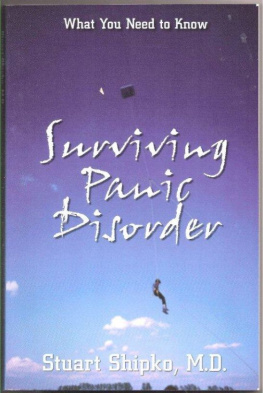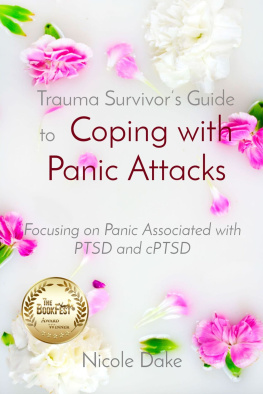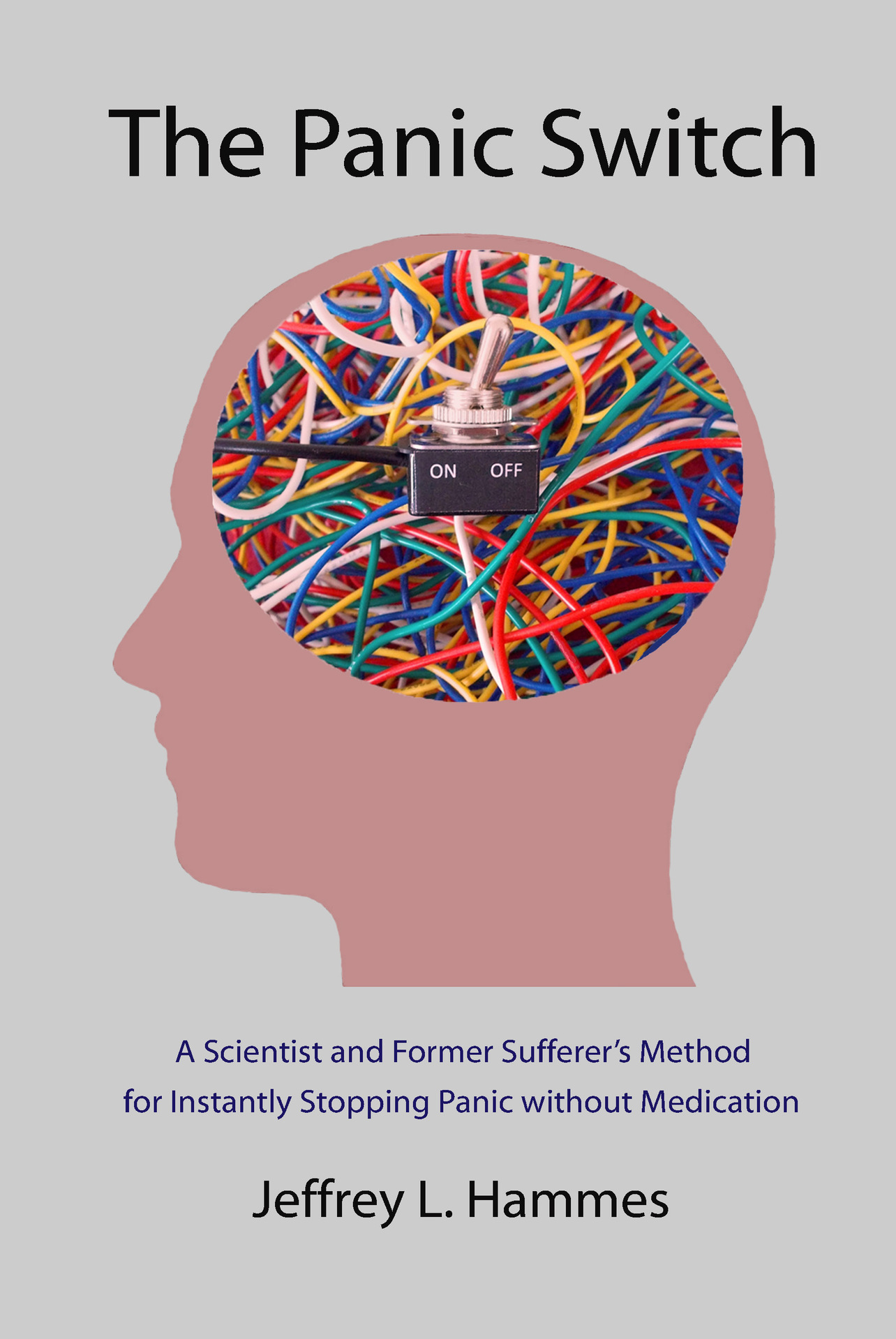The Panic Switch
A Scientist and Former Sufferers Method for Instantly Stopping Panic without Medication
Includes Chapters on Marijuana and Unreality
Jeffrey L. Hammes
The Panic Switch: A Scientist and Former Sufferers Method for Instantly Stopping Panic without Medication
Copyright 2013 by Jeffrey L. Hammes
No part of this book may be reproduced or transmitted in any form or by any means, electronic or mechanical, including photocopying, recording or by any information storage and retrieval system, without written permission from the author.
All rights reserved.
ISBN -13: 978-1493608256
ISBN -10: 1493608258
DISCLAIMER:
Sure, youre thinking, Wait, if he is telling me the truth of his experience in getting rid of his panic attacks then why would he need to disclaim anything? My friend Steve, who is a damn good lawyer, says that, legally, it is required that I must inform you as follows : I am a scientist. I am not trained or licensed as a psychologist, psychiatrist, therapist or medical doctor, nor am I practicing any type or form of therapy, counseling, medicine, psychotherapy or psychological treatment. These are my observations and opinions derived from my experiences to date. I relate these to you in this book in the hope that through reading about them perhaps you will derive some greater understanding of your own situation that may help you in your dealing with your panic feelings. The information contained in this book is not intended nor implied to be a substitute for medical, psychological or other licensed professional advice. Always seek the advice of your physician, therapist, counselor or other qualified health care provider regarding your particular medical or psychological condition prior to starting to practice this or any alternative treatment or methodology. Nothing contained in the book is intended to be a substitute for medical diagnosis, treatment or therapy. I make no claims or guarantees.This book simply provides you with a compilation of my observations and experiences to date . Summaries, strategies, tips and tricks are only recommendations by the author, and reading this book does not guarantee that ones results will exactly mirror the authors own results.
Throughout this book there are references to works by Dr. Claire Weekes and Dr. Albert Ellis. This book has not been endorsed nor are there any connections; personal or economic with these two authors, their families, heirs, business associates or any other connections to these authors, legal or associative. This book is not a representation of the work by other authors . Reference to names of authors and commercial products and processes does not imply their endorsement nor having been endorsed by these authors, products or processes.
One final disclaimer: The anecdotes which appear in this book are based upon original posts and chats which I and others have authored on my website, and through correspondence by email. The name, gender and particular vernacular of every other author quoted in those anecdotes has been withheld and randomly changed in multiple ways by me in every instance to preserve the essential information to be derived from the anecdote while protecting the identity and all health information of all authors who have posted or chatted on my website, or directly emailed me. Any resemblance between the authors quoted in the book and any person(s) any reader of this book may know or think they know is purely coincidental because as to every anecdote appearing in this book: author gender has been neutralized or randomly assigned, colloquial language has been eliminated or substituted in to protect the authors locale, peculiar language patterns have been changed, analogous fact patterns have been substituted for particular fact patterns, and in all instances the minimum amount of information provided by every such author has been disclosed in this book. As written this book provides all of the essential hopefully transformative information while strictly protecting the identity of those who have authored posts, participated in chats on my website or have sent email to me personally.
What I will not disclaim: The truth of my personal observations and experience to rid myself of the terrifying sensation euphemistically called panic attack. Through my website and my effort to write this book I intend and hope to continue to help others to do likewise.
Contents
1. Speaking Directly the Panic Sufferer
2. Anxiety
3. Something is Wrong with Me
4. Marijuana
5. Unreality, Depersonalization, Derealization
6. PanicEnd.com Annotated Version
7. (Informative) Success Stories
8. Ending the Panic
Bibliography
Give light, and the darkness will disappear of itself.
Desiderius Erasmus
Speaking Directly to the Panic Sufferer
If you purchased this book then you are probably looking for help with your panic attacks right now! You dont want to read chapters like Anxiety Through the Ages or How My Body Works . I am going to skip all the introductions and get right into the main concept. So for the cheapskate who peruses the bookstore shelves or quick looks e-books by skimming and thumbing for the main points (like me) you have struck gold my friend!
You might call panic attacks by other names anxiety, anxious feelings, losing control, phobia, nervous breakdown, or have no name for them except those weird fear feelings of going crazy! But what you really have is worrying in an extreme form. Your worries have gone beyond just fretting and wondering. The whole body is now involved in the worrying process and you are perhaps afraid of many physical symptoms such as eye focusing, dizziness, lightheadedness, nausea, heart racing, and more, that your body may be producing. You feel out of control! You may be entertaining superstitious notions of recent things in your environment as having a possible link or cause - things like your drinking water or even your shampoo color. You are wishing to be normal again so badly that you are searching for, and testing, anything to alleviate your fear.
How much stress is created by worrying? Are we worrying over real tangible things or events? Is it possible to worry about worrying? When a panic sufferer experiences their first panic attack what do they tend to focus on? They focus on their bodies - searching for something wrong with their body. They may develop obsessive tactics in an attempt to control these panic feelings. They might recite positive self-talk or religious verses, lay in bed hiding under the covers, or carry out a routine the exact way as before the panic feelings arrived hoping to regain the lost mental control.
But do they really look inside? Could the tension that accumulated in their bodies have boiled over and the high levels of nervous stress precipitated their fear of losing control? Once the fear of losing control - albeit dying or insanity or another serious event - becomes primary as a threat, then the autonomic nervous system kicks into a full protective mode of operation. Then arrives the ultimate feeling of loss of control: the panic attack! The panic sensations are feelings that are outside of your wishes and desires. Your body (which includes your brain) now bypasses your conscious reasoning and cognitive thoughts, and your survival becomes its only purpose. You have directly informed your body that there is danger to your existence and your panic ensues. This is all perfectly natural and predictable. But the panic sufferer is confused and can't understand what the body is so afraid of! It's an unknown! Now cognitive worrying has risen into an incognitive panic sensation that is something new, uncontrollable, and seemingly endless. Then the cycle of being afraid of the panic begins. Again and again as if feeding off of each panic event.













